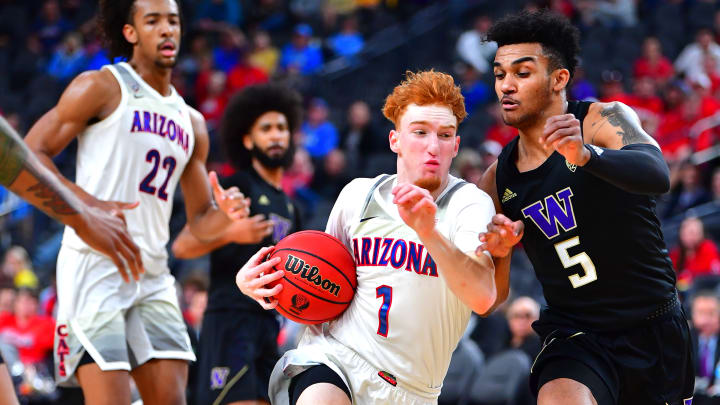Knicks Draft Breakdown: Nico Mannion, Arizona

Though the NBA is on hiatus and the NCAA has shut down the tournaments that typically account for great scouting opportunities as top prospects face off against elite teams, it’s likely the NBA draft will go on in some form. As the Knicks weigh their options, the deep 2020 point guard class gives them the chance to fill a major hole on the roster.
All season at Arizona, Nico Mannion has demonstrated the qualities of a leader and modern NBA player, though by season’s end, his inconsistency and lack of efficiency dropped him near the end of the lottery on most analysts’ draft boards. There is plenty of reason to believe, however, that Mannion would be a solid fit with the Knicks, especially considering how he could play off of 2019 No. 3 pick R.J. Barrett.
“When we’re turning defense into offense, it kind of fuels us,” Mannion said of this year’s Arizona team.
While the Knicks only consistent strength as a team over the course of the season was rebounding, it’s easy to see how controlling the possession game could help Mannion. New York was eighth in offense from the time Mike Miller replaced David Fizdale as head coach, per Cleaning the Glass. The team was just middle of the pack in terms of transition points per possession, showing an immediate area in which Mannion could help. It’s hard to know how the next Knicks coach will play or who will be on the team next season, but building around two dynamic open-court perimeter players in Mannion and Barrett would be a great place to start.
Throughout the season at Arizona, Mannion focused on pushing the pace and running sets in semi-transition.
“When we do that, we’ve got guys who can make the right play, great passers, so when we’re playing unselfishly and playing fast, things go well for us,” Mannion said.
It led to plays like this, in which Mannion’s impressive passing off a live dribble and shooting ability were maximized.
When the court got smaller, the story was different. On 97 possessions this year in which Mannion dribbled off a pick, according to Synergy tracking data, he took the ball to the hole just 13.4 percent of the time, or 13 total tries. He was 5/10 on shots in those situations and constantly turned the ball over. It’s clear Mannion avoids or is not able to drive all the way to the hoop in the half-court.
Take a look at three separate late-clock situations in which Mannion goes to a tough floater or jump shot rather than getting to the rim:
There may still be reason for hope. “I saw him as a guy that had the ability to remain calm, make good decisions and stay under control as things tightened up,” Steph Curry’s trainer, Brandon Payne, told The Athletic last year. Mannion is certainly calm at all times, but will have to overcome physical limitations to affect the game as a scorer at the NBA level.
Mannion shot just 35.5 percent in the halfcourt compared with 39.1 percent overall this season. The freshman has also drawn shooting fouls on just 7.8 percent of his halfcourt possessions this year. If it is this difficult to create separation and finish against the Pac-12, imagine what it will be like against the athletic, physical big men of the NBA.
That’s where Barrett comes in. At his best, the rookie attacked closeouts as a scorer and passer. Dumping the bad pull-up threes will be the key to Barrett increasing his efficiency, and passing has always been an under-used part of his skill set. Making better decisions (some of those turnovers were ghastly) and shooting better than 54 percent at the rim will bring Barrett closer to the type of player he was expected to be out of high school. It’s not hard to imagine Barrett’s size and athleticism helping him become a nasty secondary play-maker while Mannion leverages his shooting and passing into better spacing in the halfcourt.
Though Barrett’s minus-2.0 Defensive Player Impact Plus-Minus paints him (correctly) as a poor defender in his rookie season, there is untapped potential there as well. It’s why Barrett still went ahead of more developed defensive players like Jarrett Culver and De’Andre Hunter in the draft. His physical gifts mean he could improve dramatically over the course of his first contract, and he showed flashes at Duke, too.
Mannion profiles similarly. Very few numbers (besides a decent 2.1 percent steal rate) exist to properly measure college defenders, but Mannion plays hard on that end. Not to fall into the trap of the unathletic, “hard-working” point guard, but Mannion works a lot harder to beat ball-handlers to their spots and fight through screens than other recent draft picks like Trae Young or Ja Morat.
At Duke, a pretty good template was given for how not to put a team around Barrett. With the helpless Cam Reddish and non-shooting Tre Jones, the court shrunk to a claustrophobic box. Barrett forced bad shots and turned the ball over too much. Though we’ve never seen Barrett in a high-flying system, Mannion can help the Knicks get there, and can shoot, pass and defend well enough to complement Barrett. Should the next coaching staff finally commit to Mitchell Robinson, pushing the pace and running a screen-and-move system in the halfcourt would suit him the big man well, too.
Several options face the Knicks in this year’s draft, and reports acknowledged this week that Mannion was one of the biggest fallers of the spring in NBA executives’ eyes. Still, whether the Knicks look at Mannion with their own pick or the Clippers’, Mannion looks the part of a particularly strong fit alongside the team’s other perimeter building block in Barrett.
